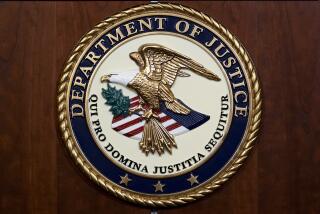Effect on U.S. Politics Still Felt
No one since Franklin D. Roosevelt reshaped American politics or restored the primacy of the presidency more than Ronald Reagan.
Reagan redefined the message of the Republican Party, expanded its reach to working-class voters who had rejected it for decades, and put in place the final pieces of a conservative alliance that has carried the GOP to unified control of Congress and the White House for the first time in half a century.
As the “Great Communicator,” Reagan changed the way presidents pursued their goals, elevating the role of direct communication with the public through television. He hastened the realignment of the South from solidly Democratic to the cornerstone of GOP strength. And he crystallized an antigovernment populism that still constrains Washington’s role in society.
During the New Deal period ushered in by Roosevelt, “the burden of proof was on those who tried to argue that government should not act,” said veteran Democratic strategist Bill Galston. “But in the era of Reagan, which I think we are still in, the burden of proof is on those who think the government should act. And if you bear the burden of proof, you have the problem.”
Following a series of presidents who failed in one way or another -- Lyndon B. Johnson, Richard Nixon, Gerald R. Ford and Jimmy Carter -- Reagan at the most fundamental level demonstrated that from the Oval Office, a talented leader could change the country and the world.
After more than a decade of traumas at home and abroad -- from Vietnam and Watergate to gas shortages and inflation -- he showed that a president could achieve many of his goals, maintain public support and prosper politically.
Reagan left the GOP liabilities as well as assets. His unwillingness or inability to cut overall government spending while massively reducing taxes triggered huge federal deficits that tarnished the party’s reputation for fiscal responsibility.
His identification with those who sought to ban abortion or revive prayer in schools strengthened the GOP in the nation’s socially conservative regions, especially the South. But it also left an opening with socially moderate voters that Bill Clinton later exploited to realign many affluent suburbs outside the South toward the Democrats.
Reagan thus sharpened the jagged cultural divisions that have produced a nation divided almost exactly in half between the two parties. “When he left, it wasn’t a 50-50 nation, but he set in motion the Democratic revival,” said Rice University political scientist Earl Black.
A former Democrat, Reagan exploded onto the national political stage with a 1964 speech promoting the presidential candidacy of Barry Goldwater. Goldwater’s campaign marked a watershed in the evolution of conservatism. But Reagan ultimately proved far more influential than Goldwater in defining the movement.
Reagan could be a bruising political adversary: As governor of California, he engaged in fierce battles with student protesters and other elements of the left. But by the time he reached the White House after defeating Carter in 1980, he had perfected a sunny, optimistic version of conservatism that celebrated America as a “shining city on a hill,” yet did not seem fixated on attempting to re-create bygone days.
This was a significant switch for conservatives. Before Reagan, the defining dictum for the American right was laid down by writer William F. Buckley Jr., who once said that conservatives’ role was to “stand athwart history and yell ‘stop.’ ”
Reagan embraced the religious and social values of the small-town America in which he was reared, but he projected them onto a future that he promised would be brighter than the past.
Guided by such principles, Reagan laid in the central pillars of the Republican Party’s current agenda: social conservatism, opposition to taxes, support for high levels of military spending and an antigovernment populism echoing the famous declaration in his first inaugural address that “government is not the solution to our problem; government is the problem.”
Reagan’s deeds didn’t always match his words. After the sweeping tax cuts he pushed into law his first year in office, he was much more cautious about pursuing spending cuts following sharp losses by the GOP in the 1982 congressional races. Although he restrained the growth in discretionary domestic programs, total federal spending rose more than twice as fast during his two terms as it did during Clinton’s.
And throughout the Reagan years, many prominent conservatives groused that he paid only lip service to social issues such as banning abortion; of his three appointments to the Supreme Court, two voted to affirm the legal right to abortion. For all his tough talk on welfare, Reagan never proposed rolling back the right to benefits to the degree Clinton did in the mid-1990s.
Yet those compromises -- like his blending of traditional moral rhetoric with forward-looking optimism -- may have helped Reagan expand his audience far beyond traditional Republican circles.
“Whether it is the auto workers in the Detroit suburbs or the small-businessmen and women throughout the Midwest, Reagan made a cultural change in the party where average people felt comfortable calling themselves Republicans,” said Gary Bauer, who served as Reagan’s domestic policy advisor during his second term.
In fact, the expansion in the GOP’s base began before Reagan. Nixon, especially in his 1972 race against Democrat George S. McGovern, benefited from political tides most identified with Reagan: the shift toward the GOP among blue-collar voters in the North and evangelical Protestants in the South.
But Reagan cemented those conversions and attached them to a far more conservative agenda. “Nixon seemed to be more about what we were not -- we were not McGovern Democrats,” Bauer said. “Whereas Reagan felt much more comfortable talking about the values that we did represent.”
But Reagan exerted his most enduring electoral impact in the South. The virtually monolithic support that Democrats had enjoyed in that region for a century after the Civil War had begun to crack in the 1960s, in the white backlash against the passage of the civil rights and voting rights legislation.
Reagan dramatically accelerated the movement toward the GOP: When he left office, the percentage of white Southerners who identified themselves as Republicans had doubled in just eight years.
Still, the GOP was not a majority party when he stepped aside in 1989. At that point, Republicans had lost many of the House and Senate seats they gained during his 1980 landslide victory over Carter, and Democrats still controlled both chambers.
But Reagan established the foundation for the GOP gains since then. Both the Republican majority in the House and Senate, as well as George W. Bush’s razor-thin electoral college majority in 2000, rest on the party’s dominance in the South, an advantage bequeathed to them largely by Reagan.
Reagan also triggered changes that helped revive the Democrats. His 49-state victory over Walter F. Mondale in 1984 inspired the creation of the centrist Democratic Leadership Council, which spearheaded the critique of traditional liberalism that led to Clinton’s “New Democratic” message and his presidential victories in the 1990s.
“It was the 1984 election that I think convinced people ... that the old version of the Democratic Party, whatever its historical and moral merits, was no longer a viable majority party,” said Galston, who served as Mondale’s issues director in 1984 and later worked in the Clinton White House.
Much of Clinton’s agenda -- which sought to balance opportunity and responsibility and prove that government activism was compatible with fiscal restraint -- tried to retool liberalism to respond to Reagan’s criticisms of it.
At the same time, Reagan inspired thousands of young conservatives who have come to dominate every aspect of the Republican Party, from its elected officials to its executive-branch appointees and political strategists. Almost everything about George W. Bush’s presidency -- from its focus on tax cuts to its moral certitude -- reflects Reagan’s imprint more than that of Bush’s father, George H.W. Bush.
This may be the most telling measure of Reagan’s impact. He shook the political landscape so powerfully that he became one of the few who profoundly influenced both major parties, forcing Democrats toward the center while tilting Republicans toward the right.
Long after he returned to California, Reagan shaped the choices that his successors could pursue. He does so even today.
More to Read
Sign up for Essential California
The most important California stories and recommendations in your inbox every morning.
You may occasionally receive promotional content from the Los Angeles Times.










